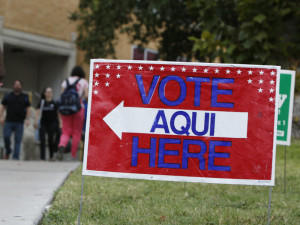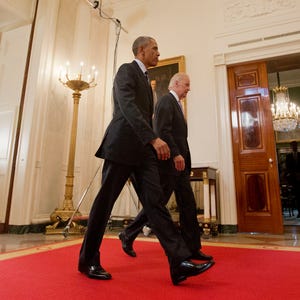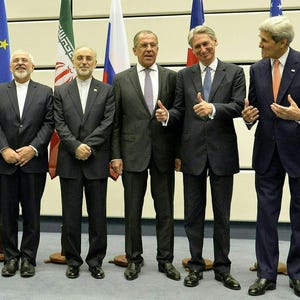Charlie’s Lament: The Greatest Tax Story Ever Told
How U.S. companies learned to relocate their official addresses overseas and avoid taxes—in one operetta.
The only operetta ever written about Subpart F of the Internal Revenue Code made its debut on a rainy Sunday evening in May 1990, in a Fifth Avenue apartment overlooking Central Park. In bow ties and spring blazers, partners of the law firm of Davis Polk & Wardwell dined on lobster prepared by a Milanese chef. Then everyone gathered around a piano, and a pair of professional opera singers, joined by the few Davis Polk men who could carry a tune, performed what sounded like a collaboration of Gilbert & Sullivan and Ernst & Young.
The 13-minute operetta, Charlie’s Lament, told how the party’s host, John Carroll Jr., invented a whole category of corporate tax avoidance and successfully defended it in a fight with the Internal Revenue Service. The lawyers sang:
The Feds may be screaming,
But we all are beaming
’Cause we’ll never pay taxes,
We’ll never pay taxes,
Never pay taxes again!
The first corporate “inversion,” as Carroll’s maneuver came to be known, was obscure then and is all but forgotten now. Yet at least 45 companies have followed the lead of Carroll’s client, New Orleans-based construction company McDermott International, and shifted their legal addresses to low-tax foreign nations. Total corporate savings so far: at least $9.8 billion—money that otherwise would have gone to the U.S. government.
This year, inversions have received more attention than ever, as well-known companies such as Burger King and Pfizer announced plans to change their addresses. (Pfizer didn’t follow through.) In July, President Obama called the practice an “unpatriotic tax loophole” and urged Congress to put a stop to it. In September, the Department of the Treasury tightened regulations to discourage the deals. “My attitude is, I don’t care if it’s legal,” Obama said in July. “It’s wrong.”
If history is any guide, the stiffer regulations won’t stop the exodus. Ever since the McDermott deal, inversions have been the subject of legions of congressional hearings, bills, and regulations, yet companies continue to find ways to circumvent them and escape the U.S. tax system.
John Patrick Carroll,
You’re the man for me.
You have a firm that is first-rate.
You have the skill to solve
this tax quandary
(Although you come in
to work very late).
Around the Manhattan offices of Davis Polk, Carroll was known as a wit and a curmudgeon. To keep fellow lawyers on their toes, he slipped nonsense words, such as “phlaminimony,” into legal documents. He always seemed to do his best work in the middle of the night. His office was a mess. He didn’t own a television set. If someone asked how he was doing, he’d reply, “They haven’t caught me yet.”
A Brooklyn native who served in the Marine Corps in China during World War II, Carroll attended Cornell University and Harvard Law School. He worked at the IRS before joining Davis Polk in 1957, when the firm still required its men—there were no women partners as yet—to wear hats. A committed liberal, he was one of the few members of his firm to oppose the war in Vietnam. He once considered leaving the practice to work for antiwar candidate George McGovern’s 1972 presidential campaign. “He would stop by my office and say, ‘Let’s go commit lunch.’ He had all sorts of wonderfully fictional phrases for noncriminal crimes, like ‘mopery in the second degree,’” says M. Carr Ferguson, a colleague. “I simply adored him.”
Carroll proved to be a brilliant pioneer in corporate law. He helped open the North Sea to oil exploration and invented a financial instrument known as the currency swap, now a $2 trillion-a-day market. Carroll was modest about that achievement. When a book credited him with inventing the swaps, he penned a tongue-in-cheek letter explaining that, although he attended the London brainstorming sessions where the idea was hatched, he was merely “a foreigner who attended most meetings principally for beer and free lunch.” He named five others who he said deserved more credit.
Around 1980, Carroll got a call from a client: Charles Kraus, the tax director at McDermott, a construction and engineering giant with a thriving business in building offshore oil rigs. Throughout the 1970s, high oil prices, helped by the Arab oil embargo and the revolution in Iran, had kept its tugboat crews and welders busy from Indonesia to Saudi Arabia. McDermott was the biggest company in Louisiana’s booming oil-services industry. It occupied half of a downtown skyscraper and, at its peak, employed more than 40,000 people around the world.
My name’s Charlie. Here’s my problem:
Our subsidiary
Pays too much in bloody taxes.
It’s dying fiscally.
As Kraus explained to Carroll, McDermott’s profits had created a big tax problem. Most of the income had been earned abroad, and the parent company in New Orleans couldn’t touch it without first paying U.S. taxes on it—at a rate of as much as 46 percent. The earnings were piling up in Treasury bonds offshore. When they came back, the total bill would be about $220 million.
John, be a hero; cut our
tax down to zero,
Because if your plan’s not inspired,
Next month we may all be fired!
After months of kicking around ideas, Kraus and Carroll hit upon an elegant but untested solution: Simply flip the company structure, so its main foreign subsidiary, incorporated in Panama, becomes the parent. Just like that, all those offshore profits would slip out from under the U.S. corporate tax system. Carroll nicknamed it the Panama Scoot. There was something screwy about the plan, like a daughter legally adopting her own mother, and the details were staggeringly complicated, involving share swaps, dividends, and debt guarantees. But Kraus and Carroll were convinced it would work.
Kraus, now 85, is a slight man who relishes the arcana of tax accounting. He once dreamt of becoming a concert pianist, and he used to spend his free time rehearsing Chopin’s polonaises on his baby grand piano. During an interview in his pink-brick home in the Louisiana woods, he recalls using a different name for the novel deal he helped put together. “We called it the Flip Flop,” he says, laughing, his hands folded behind his head. “There was a loophole in the law, and we capitalized on it legitimately.”
Kraus’s boss, John Lynott, McDermott’s chief financial officer at the time, says he sometimes puzzled over Carroll’s motivations. “It was always an enigma to me,” Lynott says. “We knew this guy was a Democrat, and yet he would take on the government in a New York minute over a tax issue. There was nothing liberal about his thinking as far as the tax code was concerned.”
John’s really flipped this time.
He’s surely lost his mind.
If we should do it,
I know we shall rue it.
We’ll pay interest, penalties and fines.
The McDermott team knew the deal would face resistance. Shareholders needed to approve the transaction, requiring a public announcement and a filing with the Securities and Exchange Commission, which would inevitably forward the papers to the IRS.
Then there was the U.S. Navy. McDermott was a major supplier of nuclear fuel and boilers for the fleet. When Admiral Hyman Rickover, the father of the nuclear Navy, caught wind of the plan, he was alarmed enough to summon Lynott and another executive to Washington. Lynott says he and his colleague spent half a day waiting outside Rickover’s office until they realized the admiral was snubbing them and had left the building. They flew back to New Orleans on their private jet without meeting Rickover. Eventually, the Navy set aside its concerns about Panama, Lynott says. “They were reassured there was nothing there but a post office box,” he says. “We weren’t moving anything.”
McDermott disclosed the plan publicly on Oct. 28, 1982. The next day, the New Orleans Times-Picayune quoted the company’s chairman, who assured the community that “no changes in the operations and management of the company are planned, and the principal executive offices will remain in New Orleans.” Shareholders had no objection, and by December, the address change was official. Kraus hung a skull and crossbones in his office, a nod to Panama’s piratical past.
Once the deal was announced, McDermott rushed to complete it as quickly as possible, according to Carr Ferguson, who was a federal tax prosecutor before he joined Davis Polk. They were hoping to reduce the chance the Treasury Department would learn about it and ask Congress to block it. As it was, no one heard from the Treasury until the following January, when Ferguson got a call from a top tax official he knew there.
“Carr, you can’t do this,” Ferguson remembers the official saying.
“That was my first impression,” Ferguson replied, “but we worked at it pretty carefully, and we think we can.”
“You’re going to have to prove that in court to me.”
Move down to Panama!
Think of our painful chagrin:
The Feds will be cheerful,
and we will be tearful
’Cause we’ll all end up in the pen!
The IRS fought the case for seven years, giving up in 1989 only after a federal appeals court upheld a U.S Tax Court decision in the company’s favor.
In 1984, Congress passed a law specifically designed to prevent more McDermott-type arrangements. But don’t bet against the imagination of tax lawyers. A decade later, a company in El Paso that made curling irons and hair dryers found a way to create a foreign parent in Bermuda without triggering the McDermott rule. More laws and regulations followed, in 1994, 2004, and 2009, but the deals just kept coming, each permutation more complicated than the last. Somewhere along the way, tax lawyers started calling them inversions, because they turn a company’s corporate structure upside down.
However helpful the Panama Scoot was for avoiding taxes, the new address couldn’t protect McDermott from getting clobbered by an oil slump. Lower energy prices and an economic downturn led to a series of losses during the 1980s, Kraus says. Later, the unit that supplied the Navy’s nuclear fuel was engulfed by asbestos claims. After Hurricane Katrina in 2005, McDermott moved its corporate headquarters to Houston. It closed its remaining office in downtown New Orleans last year.
In a way, Admiral Rickover’s beef with McDermott got a second life in 2007, when Congress passed a law banning federal contracts for inverted companies. Eventually, McDermott was forced to spin off the unit that worked with the Navy to avoid losing all its contracts.
Kraus says he hasn’t thought much about inversions since his retirement in 1989, nor has he followed the debate in Washington this year. He remains proud of his work. When a congressional committee in the 1980s complained that the McDermott deal made a “mockery” of the tax code, Kraus says, he half-jokingly called it “the crowning achievement of my career.”
“The law is an unintelligible monstrosity, and it’s Congress’s fault,” says Kraus, who still has a small Lucite trophy commemorating the Panama deal. He uses it as a paperweight.
A few months after Carroll’s victory over the IRS, he and his wife, Luceil, threw the party at their apartment. A video survives of the moment when, to his surprise, his colleagues began performing Charlie’s Lament, named for Kraus. A musically inclined lawyer in the tax department, William Weigel, wrote the libretto and recruited a professional tenor and soprano through his church choir. Carroll listened from an armchair, and at the finale he clapped and rose. Somebody called for a speech.
“I wrap myself in the American flag,” he said. “And I say, without the slightest fear of successful contradiction—blah, blah, blah, blah!”
Carroll retired later that year. He didn’t play a role in the copycat deals that eventually followed McDermott, nor did he seek any recognition. In a tax journal in 2007, a law professor referred to the McDermott deal’s creator as “a brilliant tax lawyer (I don’t know who).”
One of Carroll’s two sons, Brian, recalls that his father, toward the end of his career, reflected on his role in making the tax system even more convoluted. “Look, I did all these crazy things,” Carroll told him. “I would really like to see the tax code completely scrapped. The whole business of trying to define income and deductions is pure madness. And I’ve got no one to thank except myself for creating that.”
Carroll died in 2009 at the age of 84. Following his wishes, in lieu of a funeral there were parties with food and wine, including one for his many friends at Davis Polk’s Manhattan headquarters. Amid the talk and laughter came the familiar strains, playing over and over again on a TV in the next room:
The Feds may be screaming
But we all are beaming
’Cause we’ll never pay taxes no,
Never pay taxes,
Never pay taxes again!
This feature is part of a 2014 Pulitzer-Prize winning series for Explanatory Reporting. See the rest of the series here.














